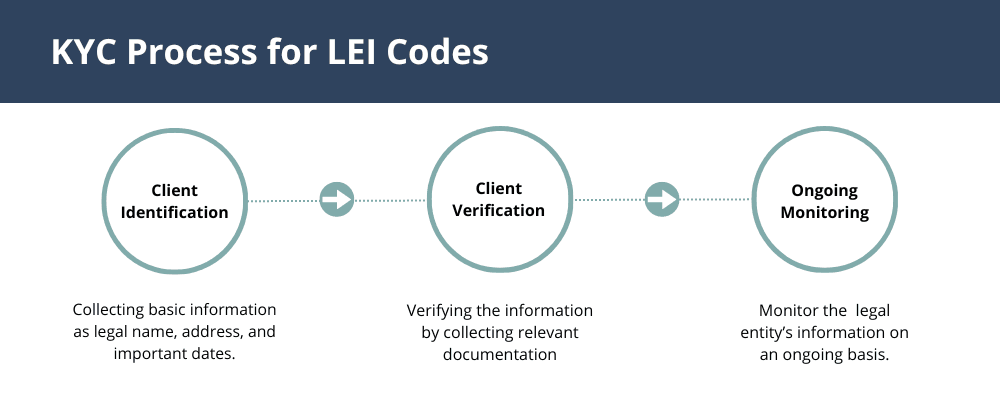Order and renew LEI codes in bulk
Get answers to all your questions about bulk ordering LEI codes
KYC is an abbreviation for the term, "Know Your Customer," and refers to the process of establishing the essential personal profile of your customer. KYC is also used in the fight against money laundering and the financing of terrorist organizations.
The term is most often used in the financial sector by banks and asset managers. But it is also used by law firms, insurance companies, and real estate agents, who are required to document their customers' identities and know from where the money is coming.
This is also where the synergy between LEI codes and KYC comes into its own, as it combines information about 'who is who', with 'who owns who'.

GLEIF has conducted a survey of 102 senior salespeople working within the banking sector to find out which challenges they face with identifying legal entities and onboarding new customers. The findings show that 57% of all senior salespeople spend more than 1.5 days of their workweek onboarding new organizations. This is time that could have been spent on acquiring new customers or servicing existing customers.
In the global economy, the verification and identification of customers is an ever-growing challenge, and a time-consuming and costly one at that. The number of providers for identification is growing, and they use different methods to update and present information, especially when dealing with transactions across different countries.
GLEIF's study also shows that 50% of sellers used a minimum of four different identification methods to complete the onboarding process of a single customer.
Even when the customer is identified and the onboarding process is completed, the data must still be kept up to date throughout the customer relationship. There is no standardized way of doing this. Different identification providers use different ways of presenting data, which in turn creates inconsistencies. 57% also responded that the reliability of the data is challenging in connection with onboarding.
The global LEI system helps solve the challenge of inconsistent and unreliable company data by effectively standardizing it. When all global companies operating in the financial markets can be identified through a unique LEI code, it makes the process far less complex. Banks operate across countries, and thus also across different legal regulations, which is why it is of great importance that they can make use of a system that uses the same global standard.
By accessing the Global LEI Index, all companies can make use of the public and standardized reference data from companies all over the world. GLEIF naturally attaches great importance to the quality of data and carries out strict quality controls.
All LEI codes in the index contain information about the company's structure and parent company, which makes it easy to know who owns who. All LEI codes must also be updated at least once a year to ensure that all company data is up-to-date and correct.
You can read more in our article, ‘The global LEI system.’
Salespeople within the banking sector can avoid time-consuming tasks and costly processes by using the global LEI system. But this is only one of the many advantages of the LEI system.
The security and transparency that comes with the LEI system's way of identifying companies help reduce risks, fraud, cheating, and money laundering in the financial markets. With the LEI system, it is possible to uniquely identify who is who - so you know that the customer is really who they say they are - and you can track all transactions on the financial markets across national borders.
The LEI system is ISO standardized (17442) and publicly available, and these two things make it an extremely transparent and useful tool for all organizations working with KYC.
You can read more in our article, ‘LEI codes and anti-money laundering (AML).’
*Illustration source: *https://www.gleif.org/en/lei-solutions/lei-in-kyc-a-new-future-for-legal-entity-identification/
Get answers to all your questions about bulk ordering LEI codes
The month of January seems like a good time for a mental clean-up. How do you get your business off to a good start in the new year?
Which type of data does an LEI code contain - and how is the data updated?
We are here to help you!